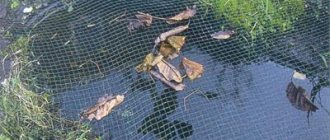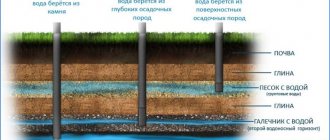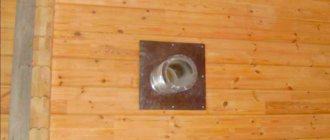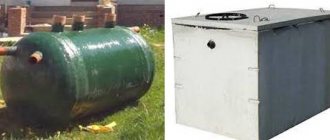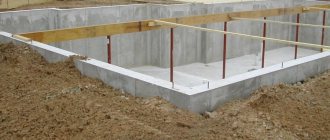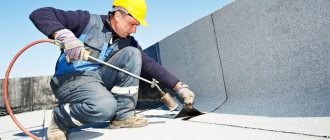For individual water supply to country private houses and cottages that do not have access to the central water supply main, the main source of water is underground pools, which are easier and cheaper to access using a well. Typically, specialized companies are engaged in drilling deep-water wells with high flow rates (fillability), but you can significantly reduce financial costs by further equipping the water well yourself.
The task is not so simple due to the many factors influencing decision-making on the well construction method; you will mainly have to take into account your financial capabilities, the casing material, the characteristics of the well source and pumping equipment, and the climate in the region where you live. When installing (piping) a well yourself, you should select in advance the type of electric water pump (surface or submersible), draw up a plan for connecting it to auxiliary devices and determine its location.
Station in a caisson
What is needed to supply water from a well?
When drilling individual wells using drilling equipment, a column of casing pipes is lowered into the mine, the material of which is polymers (unplasticized polyvinyl chloride UPVC, HDPE) or steel, sometimes plastic pipes are inserted inside metal ones at great depths. At this stage, the well arrangement diagram should be known, for example, if water is supplied to the water supply through an adapter, it is not recommended to attach it to the fragile plastic wall of the pipe; the column or its top should be made of metal.
To understand how to install a water well after drilling, you should consider all the equipment and engineering structures that are needed to deliver water to the internal water supply of the house. To provide housing with well water you need:
Casing string . After passing the borehole channel, a column of pipes 6 m long is immersed into it, which are connected to each other by means of threads. It must have smooth, strong walls that can withstand external soil pressure, and a diameter suitable for immersion of the selected electric pump model.
Recently, individual drilling of Abyssinian wells by private individuals has become popular in cases where the water surface on the site is closer than 9 m from ground level. To do this, use a hydraulic drill to make a narrow hole in the ground and immerse a low-density polyethylene (HDPE) pipe with a homemade filter at the end inside, which is connected to a surface electric pump. The depth of homemade Abyssinians reaches 30 m; the casing and supply pipeline are simultaneously a HDPE pipe section lowered into the channel.
Devices for immersing the pump and suction hose into the source . When lowering a deep-well pump, always use a head or cover with an adapter connection, to which the unit is tied and the supply pipe is attached. When attaching the adapter, the water supply pipeline is passed through its side fitting, fixed to the wall of the column.
Piping diagram for a well with a deep-well pump
Electric pump . There are two groups of electric pumps for supplying water: submersible and surface, the first are lowered into the well to a great depth, so that they plunge without interference, a casing of a suitable diameter from factory well pipes is required. Surface electric pumps for water intake from depths of up to 9 m use a narrow hose or a water pipe of small cross-section, so a wide column is not required for their operation - this is the determining factor when using them to suck water from Abyssinians.
Automation. To turn off the pump after filling the water supply system, a pressure switch is used, a pressure gauge is installed to configure and control it, an expansion tank is used to store water reserves and maintain pressure in the line.
The listed devices are the main components of a household water supply main with an electric pump; when using surface types, all of the listed elements and the pump are often assembled into a single unit - a pumping station.
Selecting pipes
Here you need to correctly calculate the required amount. Take note of the slope and number of turns.
Having correctly identified them, you can take them in the required manufacture; they differ in the angle of rotation and this will greatly facilitate the work:
The diameter of any pipes made of different materials (steel, polypropylene, metal-plastic) must be from 32 mm.
When choosing pipes, you should pay attention to ensure that the material they are made of is food grade and not technical grade.
Be sure to check this out; We need to supply pipes to the premises; the trenches from the well to the foundation of the building must be at least a meter deep. It is important that the level of laying pipes in the trench is below the freezing level of the soil in your area. It is necessary to provide reliable protection by covering the pipeline with insulation (see How to insulate a well correctly)
For this, mineral wool is used. It’s even better if you also lay a special electric cable for heating, which will provide heating and prevent the pipe from freezing; An above-ground option for laying pipes is also available. In this case, measures to insulate the external water supply must be carried out. The pipes are laid directly on the ground, or in a preliminary recess. At the same time, a heating electric cable is laid, but in this version it must already be present.
Caisson or adapter - in what type of wells is it installed?
To provide water to individual houses, wells are drilled, which are divided into three categories:
Abyssinian . This type of well is installed when aquifers are located at a shallow depth from the surface; hydraulic drilling is carried out by individuals and organizations. The Abyssinian well is drilled within 24 hours; instead of casing pipes, a piece of HDPE pipe with a filter at the end is taken. The depth of the Abyssinian depends on the location of the aquifer and lies in the range of 5 - 30 m. The water surface in the Abyssinian should not fall below 9 m; external centrifugal electric pumps or stations, which are located in close proximity to the source, are used to draw in water.
To protect the external pump from precipitation and frost in winter, an insulated coffered well is installed in the Abyssinian area.
Wells in the sand . This is the main type when the water table from the ground level is below 9 m, the depth of the wells ranges from 20 to 60 m, a submersible pump is used for intake. When installing a deep-well electric pump, it is easier and more cost-effective to connect it through an adapter screwed into the side of the casing wall; the caisson is not mounted.
Artesian . To access water artesian basins, a well with an average depth of 100 m is drilled; in domestic water supply sources it can be larger, but at depths of more than 200 m, already significant costs increase sharply due to the use of industrial technology for drilling such distances.
Due to the pressure of earth layers on a deep water basin, water from artesian wells often rises to a great height and even comes to the surface; a surface electric pump is used for supply and a caisson well is installed accordingly. No one forbids extracting water from an artesian source with a deep-well pump, which has higher efficiency and characteristics; when installing it, it is more economical to use a well adapter to drain water into a house.
Although the use of an adapter is more rational when operating deep-well pumps for water intake, a caisson well has the advantages of convenience when it is necessary to remove and maintain a submersible electric pump, and it also protects the well channel from freezing in winter. Therefore, a caisson is often installed when lifting water with a submersible pump, placing automation in it: a pressure and dry-running switch, a pressure gauge, a hydraulic accumulator.
Surface pumps and pumping stations
Non-specialized requirements
In practice, in order for water to easily rise to the surface, it is necessary to carry out a complex of works. They include the installation of the necessary equipment designed to transport it to the house and to the site, since there will be no other way to use the well.
The arrangement process has several stages, the instructions require you to create them one after another. It is forbidden to skip any of them, otherwise you risk expensive equipment in advance.
Well piping includes:
- installing a caisson directly on the upper part of the casing or at the wellhead;
- selection of pumps and their installation, filter systems for the well, the necessary equipment to provide power to the entire system. There are options in which, when arranging a caisson, a hydraulic tank is installed inside, which maintains the amount of water required for constant pressure;
- construction of a trench and laying a pipe system in it to water intake points, as well as to the bathhouse and home boiler room;
- installation of main and additional equipment that has not yet been installed in the caisson.
Adapter installation
Installing an adapter for connecting a submersible pump is not a complicated operation, but requires an electromechanical tool (drill, hammer drill) and special components: metal bits with the diameter of the adapter, pipes with a threaded groove about 2 m long for the installation adapter thread.
Although the pump is suspended from a sealed well cap, the adapter experiences the load of the water column in the pressure hose, it can withstand a weight of 500-600 kg, which cannot be said about the walls of the uPVC casing pipe, which experience additional soil pressure - this can cause a change in the geometry of the shell and the appearance of leaks in fitting fastening area. Therefore, the adapter is cut into the metal pipe of the column, installation is carried out as follows:
- Dig a hole around the casing and a ditch below the freezing depth of the soil from the well to the house with a depth of about 1.5 m.
- Use a grinder to cut off the top of the casing pipe. Usually it is buried underground and covered with an airtight lid, but this does not guarantee protection against groundwater entering the canal, so a small section of pipe is often left at the top.
- Prepare the electric pump for immersion by connecting a cable or pressure pipeline to it, which are tied together with the power cable with ties or insulating tape.
- A hole of the required diameter is drilled in the wall of the casing pipe using a metal crown, and one part of the adapter is inserted from inside the pipe. To do this, it is completely assembled, screwed onto the mounting pipe and lowered into the well, illuminated with a flashlight.
Downhole adapter
- After inserting part of the adapter through the side hole of the casing pipe, it is clamped with an outer nut through the rubber gasket with an adjustable wrench, and the mating part together with the mounting pipe is removed from the well.
- Cut the HDPE pressure pipe from the electric pump to the required length, and install the second part of the adapter with a dovetail connection on the free end.
- Screw the mounting pipe to the mating part of the adapter and lower it together with the pressure pipelines and the electric pump into the well, fixing the dovetail connection with the part fixed to the casing.
- A sealed cap is installed over the well, a cable is tied to its inside, and the power cable of the electric pump is connected to the terminals of the junction box located in the side of the cap body.
- Through the adapter coupling, the HDPE water line entering the house is connected to the side of the adapter; upon completion of the work, the trench and hole are filled with raised soil.
Basic steps for connecting the adapter
Caisson device
When using a well source for water intake only in the summer, an external shed or pit with dimensions suitable for placing a pump and equipment, providing free access for maintenance and control, is built on a dacha plot for protection from precipitation. The walls of a dug pit of small depth are usually lined with brickwork, crushed stone is poured onto the bottom or a screed is made, and the structure is covered with an airtight lid on top.
With a constant individual water supply to the house, the summer equipment is replaced with a capital engineering structure - a caisson well, which, in addition to protecting the equipment from precipitation, provides its safety and thermal insulation during the cold season. Let's consider the main options for constructing caisson wells.
Concrete rings
Construction of a water well, where low price is the determining factor, is carried out using concrete rings. A caisson well is easy to assemble from standard factory parts: a bottom, two well rings with locks with a standard internal diameter of 1 m and a height of 0.9 m, a cover with a hatch, the average cost of the entire set will be about 5,000 rubles.
Tip: Purchasing concrete rings with a finished bottom and lid will further simplify installation and improve its quality.
Types and sizes of products for concrete wells
To install a well, you will need a building level, a mixture of sand and cement in a ratio of 4:1; before installation, all concrete parts are coated on the outside with bitumen waterproofing (mastic) and dried well. The well is installed in the following order:
- Dig a hole of the required dimensions in depth and width, pour sand onto the bottom and level it horizontally.
- They make a hole in the bottom for the column; to do this, draw a circle of the required diameter and drill through holes around its perimeter with a hammer drill, then knock out the middle.
- Lower the bottom onto the cut casing (30 - 50 cm from the ground), nail it with a massive rubber hammer for horizontal installation.
- A small layer of cement mortar is laid around the perimeter, the first ring is placed on top, a layer of mortar is applied to its upper edge and the second ring is lowered.
Installation of a well made of concrete rings - A cover with a manhole is lowered onto the cement mortar, to which a plastic hatch is then screwed onto anchor bolts. Using a crown, drill the necessary holes in the walls of the well and bring the pipes out.
- Coat the junction of the bottom with the casing, the cracks near the exited pipes with cement-sand mortar, and additionally remove all joints and remove excess mortar.
- For hydraulic insulation, buy a dry mixture in bags, dilute it with water and coat all joints from the inside using a spatula or brush. It would not be a mistake to carry out a similar procedure for waterproofing the inner surface of the entire concrete chamber to prevent it from becoming saturated with moisture.
- After installing the rings, insulation is carried out - their surface is covered from the outside with sheets or narrow strips of foam plastic with further fixation, then sprinkled with earth.
Note: It is difficult to insulate a round-shaped well with straight sheets of polystyrene foam; for these purposes, you can purchase a foam plastic shell from some manufacturers, which is made of several segments and assembled on the surface of the rings by inserting fragments into each other.
Metal and plastic caissons - design
Metal
Caissons made of sheet steel 3-6 mm thick are manufactured by many enterprises and commercial firms; the welded structure of the working chamber has a round or square shape, with a square or cylindrical manhole welded on top. Due to problems with corrosion, steel is always covered with waterproofing on the outside; installation of a steel caisson is carried out according to the following scheme:
- A pit is dug for a caisson and a trench for laying HDPE water pipes, the bottom of the hole is filled with a screed 10 - 15 cm along the horizon.
- Holes for pipes are cut in the bottom and walls of the metal caisson, fittings are inserted to connect the internal and external pipelines, and the caisson is lowered onto a pre-cut casing.
- The bottom of the caisson is welded to the metal casing; if the pipe is made of plastic, a rubber cuff designed for its outer diameter is used for sealing.
- Insulate the side and top walls of the caisson from the outside with foam sheets (if it is square, this is quite easy to do) and sprinkle it with earth.
The standard height of a metal caisson is about 2 meters, the width is 1 m or more, the price depends on the size, thickness of the steel sheet and the manufacturer, the minimum cost of a standard design is 20,000 rubles, the average price of a quality product is 30,000 rubles.
Strapping scheme with a metal caisson
Plastic
Chambers made of concrete and sheet steel have high thermal conductivity, so in cold weather they have to be additionally insulated, which is not always effective and leads to additional financial costs. The best winter option is plastic caissons, which are currently gradually ousting cold-weather competitors from the market; their main drawback is their high price of about 40,000 rubles. for standard quality products. Almost all plastic caissons have a cylindrical working chamber and manhole with a height of about 2 m and a different internal diameter; they are installed in the following order:
- Dig a hole in such a way that there is a gap of 20 cm between its walls and the caisson shell, level the bottom with a cement-sand screed 15 cm thick. If the area is swampy and the bottom of the hole is flooded with groundwater, lay a concrete slab with a pre-cut hole for the pipe.
- Make the necessary holes in the caisson and place it on the top of the column using a transition rubber coupling.
- Cement-sand mortar is diluted in a ratio of 1:5 and poured along the edges of the pit, filling the space between its walls and the caisson shell; 10-15 cm of mortar is not poured on top, leaving room for soil for landscaping the area.
Installation diagram of a plastic caisson
Typical user mistakes
Out of ignorance, seemingly insignificant mistakes are often made that lead to breakdowns:
- Discrepancy between water consumption and source capabilities.
- Unreliable fastening of the device in the shaft. A break in the support cable results in unacceptable stress on the hoses and electrical cable.
- Touching the wall. The result is physical destruction of the hull.
- If the bottom is too close, solid particles are captured and parts gradually wear out.
In our article, we told you in general terms how to install a well pump in different situations, and showed connection diagrams in the most typical cases. We hope that you can solve the problem of temporary water supply at your summer cottage on your own. And to install a serious structure that supplies the house on an ongoing basis, we advise you to hire competent specialists. Professionals will help you choose the most optimal model based on your preferences and financial capabilities. To further reinforce the topic, watch the video:
Pump selection and installation
In order to properly equip a water well after drilling, select the type of electric pump with the necessary characteristics; the choice of a caisson well or adapter when arranging a water supply source depends on its parameters. All electric pumps, based on their location relative to the well, are divided into two large groups, differing from each other in their parameters.
Superficial
Surface centrifugal pumps with an efficiency of about 50% are used more often than other types to supply water; for most models, the suction depth does not exceed 8 m, so they are placed next to the well or at a short distance from it.
With a large distance between the pump and the source, each vertical meter of water column is converted into 7 m horizontally with a pipe diameter of 1 inch, taking into account hydraulic losses in fittings, bends, and tees. Thus, a surface pump can be placed not only in a caisson, but also in a house if the water level is close to the soil surface, for example, with a mirror (static level) of 5 m, the electric pump can be installed in the basement of a cottage 20 m from the well.
Free-standing external pumps are very rarely used in domestic water supply; they are usually operated as part of stations where an electric pump, a hydraulic accumulator, a pressure relay and a pressure gauge are placed on one frame, connecting them through fittings and flexible hoses.
Surface household pumping stations are capable of pumping water up to 5 m3/h with a maximum pressure of about 50 m, which makes them suitable for supplying water to a house with a family of five people.
Centrifugal surface pump - internal structure
Submersible
A large group of deep-well pumps operate using a centrifugal design; such units have the highest efficiency among all types, reaching up to 65% for high-tech expensive Grundfos models. In terms of parameters, submersible pumps are significantly superior to external ones; the volume of pumped liquid in household models reaches 20 m3/h, the maximum pressure reaches 300 m thanks to the use of a number of stages with impellers that successively increase the pressure.
On the pumping equipment market there are other types of submersible electric pumps with a different operating principle; their list consists of the following types:
Vibrating
Popular household models of the electromagnetic principle of operation, sucking up water due to the reverse and forward movement of the built-in piston connected to the armature of the electromagnetic coil. The maximum supply volume of vibration pumps does not exceed 1.5 m3/h, the pressure reaches 80 m with an efficiency of about 35%.
The average price of vibration pumps is around 1,400 rubles; in everyday life they are not used for constant water supply due to low technical characteristics, they are used mainly for irrigation, drainage work, pumping wells, filling pools and reservoirs with water, and other economic purposes. Vibrating pumps can pump out very turbid and dirty water without damaging the electrical part and housing (that’s why they are used for pumping wells), but the rubber piston and return valve are worn out by sand particles and may require replacement after a while.
Centrifugal and vibration submersible electric pumps - internal structure
Screw
Units of this operating principle are often called screw units; their operating principle is reminiscent of a household meat grinder, in which the liquid moves due to the rotation of a spiral screw. Screw models are not so popular on the market; their advantage is the ability to work with viscous and turbid media. The efficiency of screw units does not exceed 50%, the flow is up to 15 m3/h, the pressure reaches 100 m.
Vortex
In this type of electric pump, water is sucked in by the blades of the impeller through an opening on the side of the housing and pushed out by the impeller through the side pipe in the same plane. The distance between the blades and the walls of the working chamber is minimal to reduce hydraulic losses, so vortex models only work with clean water from artesian wells. The efficiency of such devices is also low (about 50%), household units have average technical parameters with the highest flow of 5 m3/h and pressure of 100 m.
Screw and vortex pumps - design
Typical route method
In the first case, the regularity of natural deviation in the required area of work is used. Drilling is planned on profiles constructed in advance based on collected information about the natural deviation of wells. This method is advisable to use in well-studied terrain; moreover, the curvature of the face does not need to be controlled - you just need to adapt to the passage of the natural deviation.
The negative side of the method is considered to be an increase in the cost of constructing a structure due to an increase in the volume of drilling. Based on previously prepared wells in each area, places of the greatest intensity of deviation are identified, and profiles are compiled using the information received.
Head installation
A typical head has a simple structure; its body consists of two parts, which are connected to each other through studs with nuts, and between them there is a donut-shaped rubber ring. The top cover has holes for entering the power cable and pressure pipe (the latter is located in the center), a carabiner is welded at the bottom to secure the electric pump cable, and two eye bolts are screwed on top to facilitate landing on the well.
Installation of the head is carried out in the following order:
- Place the bottom cover and rubber donut over the column, pass the power cable through the head through the rubber seal and the HDPE pipe, and thread the loop of the cable tied to the pump into the carabiner.
- A pump with a head is lowered into the well channel using a cable tied to its eye bolts, after the top cover rests on the top of the column, 4 threaded rods are inserted into its holes.
- The nuts are tightened with a wrench, connecting the upper and lower halves of the head, while the ring in the middle is compressed, tightly fixing the structure to the surface of the pipe.
- Cut the HDPE pressure pipe, put a feed-through and compression fitting on it, and clamp the pipeline in the head.
Head installation
Drilling process
The liquid supplied when using the rotary drilling method under high pressure erodes the soil under the bit and brings it to the surface. There the liquid goes to treatment facilities. Various filters, including a vibrating sieve, release the liquid from the rock, and water is poured back into the system.
Different types of flushing fluids can be used for different rocks: clean water when working with rocky rock or a solution of water and clay for loose soil. In some cases, it is possible to blow out the well with compressed air.
The installation itself for the rotary method of drilling wells is a tower to which lifting equipment and other technical devices are attached. In the shaft of the tower, which goes into the well, there is a drill string driven by different types of engines: electric, internal combustion, a vehicle engine, which became the basis for the rotary unit.
Connecting a hydraulic accumulator, automation
To fully equip a water well, it is necessary to install a pump, equipment and automation, which include a hydraulic accumulator, relay and pressure gauge, in the prepared caisson pit. If you use a station, all the components necessary for water intake are collected in one module, all that remains is to connect its input to the pressure pipe through a compression fitting and in a similar way connect it to the water supply supply to the residential building.
When connecting a pumping station, the help of a specialist and the use of special tools are optional - the HDPE pipeline is connected with straight or angled threaded compression fittings manually, or using a wrench on metal parts.
Options for water distribution in a private house
There are two main ways to connect consumers to the water supply; when choosing an option, the volume of water consumed and the required pressure in the system are taken into account.
Serial (Tee) connection. The scheme consists of a common hot and cold water supply pipe, from which water is supplied to the consumer using tees; it is economical and easy to install. Its disadvantage is a sharp drop in temperature when several consumers are connected to the line, and the water pressure in the system of the last of them will be much lower than normal.
Parallel (collector) connection. With this method, pipes are routed separately from the common collector to each point of consumption. The system is characterized by uniform water pressure and temperature throughout, but requires a large number of pipes, which complicates installation and is more expensive than the previous option.
Rice. 3 Series and parallel water distribution
Expert advice
To properly equip a well with your own hands, you will need to make many decisions, in which any additional information will only be useful, especially if it comes from professionals in their field. The tips below will help prevent some common mistakes many homeowners make due to lack of knowledge:
- When choosing a borehole caisson, it is better to give preference to modern technologies - models made of polymers with high tightness and low thermal conductivity - this will prevent the well from freezing in the cold season. Too high a cost should not discourage you from purchasing: the production of plastic caissons is well developed, manufacturing companies often organize promotions with significant discounts, and in winter and late autumn the product can be purchased at a price 2 times lower.
- It is also not necessary to carry out drilling work only in the summer in dry weather; drilling is a year-round process, and carrying it out in winter will cost much less, and all other work can be postponed to the warm spring-summer season.
- When choosing an electric pump, they look at its technical characteristics, and you should know that the given maximum values are one and a half times higher than the nominal values at which the pump effectively sucks water.
Pumping equipment in a plastic caisson - examples of placement - If you use an Abyssinian or a well on sand, before supplying water to the hydraulic accumulator or automation elements, be sure to install a coarse sand filter; it would be useful to install another additional mechanical filter with a polypropylene cartridge.
- To avoid draining water from the system, a check valve must be installed at the outlet of the submersible electric pump and at the inlet of the surface pump.
- With limited financial resources, an Abyssinian well is drilled manually; private owners carry out this work within one day (unless they come across a large cobblestone or stone slab during excavation, after which the drilling ends). The cost of the work is approximately 100 USD; manually it is possible to reach depths of up to 35 m; for example, the depth of wells in the Moscow region starts from 5 m.
- The idea of using a well adapter should be approached with caution - the dovetail connection on two adjacent rubber rings can leak under high pressure. The purchased parts must fit very tightly into each other.
Connection diagram of the pumping station to the water supply system
Characteristics of systems that create water pressure
If we do not consider the device, then the main indicators describing the operation will be:
- Power (in terms of volume of moisture pumped and energy consumed).
- Maximum pressure.
- Optimal lifting height.
The first parameter shows how many liters the device is capable of delivering per unit of time with a given excess. A secondary characteristic is the amount of electricity consumed.
The second one indicates the highest guaranteed outlet pressure value.
The third one specifies the normal height at which the first function is performed.
Construction of a water well from A to Z: video
Below are examples of videos that clearly display many stages of well piping:
- Borehole drilling, independent arrangement of a well caisson under water, installation of a deep-well pump in a well, installation and connection of a hydraulic accumulator, automation in the caisson:
- Drilling, constructing a caisson well with your own hands, assembling a pumping station for a submersible electric pump:
- Installation of a steel coffer chamber, installation of a hydraulic accumulator and automation for a submersible electric pump:
- Installation and connection of the pumping station to the well in a caisson chamber made of concrete rings:
When piping a well, they focus on the physical parameters of the source: depth, flow rate, static level, water quality. Based on the listed factors, choose the type of pump (surface or submersible), and then the placement option (caisson, house) and connection (via a head or adapter). The complexity of the filtration system depends on the quality of the water; usually artesian sources require the use of expensive purification systems for removing metal oxides and hydrogen sulfide.
Causes of system failures
Ordinary users often do not know how to properly hang, secure and connect a submersible pump in a well. This leads to premature failure of both the unit itself and communications. Excessive vibrations can also lead to accelerated siltation of the source.
Most often, the main element stops functioning for the following reasons:
- Overheating as a result of all the water being used up.
- Mechanical destruction from long-term contact with walls.
- Power failure due to improper hanging.
- Abrasive wear of parts due to the bottom being too close.
